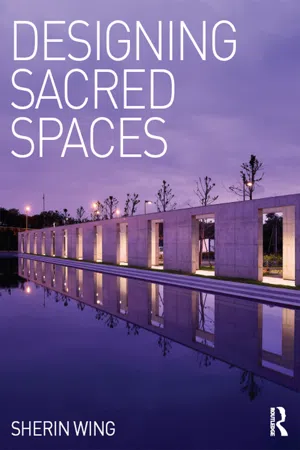
- 320 pages
- English
- ePUB (mobile friendly)
- Available on iOS & Android
Designing Sacred Spaces
About this book
Sacred spaces exemplify some of the most exciting and challenging architecture today. Designing Sacred Spaces tells the inside story of seven architecture firms and their approaches to designing churches, mosques, synagogues and temples, monasteries and retreats. Twenty beautifully illustrated case studies located in Asia, Europe, and North America are showcased alongside discussions with the designers into concept and design development, materiality, and spatial analysis. Complementing these are essays on the cultural, historical, and theoretical meaning and importance of sacred spaces. By exploring the way we see religion and how we understand secular and sacred space, Designing Sacred Spaces reveals how we see ourselves and how we see others. A tour-de-force of first-person narratives, research, and illustrations, this book is a vital desk reference.
Frequently asked questions
- Essential is ideal for learners and professionals who enjoy exploring a wide range of subjects. Access the Essential Library with 800,000+ trusted titles and best-sellers across business, personal growth, and the humanities. Includes unlimited reading time and Standard Read Aloud voice.
- Complete: Perfect for advanced learners and researchers needing full, unrestricted access. Unlock 1.4M+ books across hundreds of subjects, including academic and specialized titles. The Complete Plan also includes advanced features like Premium Read Aloud and Research Assistant.
Please note we cannot support devices running on iOS 13 and Android 7 or earlier. Learn more about using the app.
Information
PART 1 Introduction
Chapter 1 Introduction
Notes
- Paul Eli Ivey. Review, Gothic Arches, Latin Crosses: Anti-Catholicism and American Church Designs in the Nineteenth Century by Ryan K. Smith; American Sanctuary: Understanding Sacred Spaces by Louis P. Nelson, Journal of the Society of Architectural Historians, Vol. 67, No. 3 (September, 2008): 456.
- Website: Ivey, 2008: 454.
- Website: Ivey, 2008: 455.
- Michael J. Walsh, “Efficacious Surroundings: Temple Space and Buddhist Well-being,” Journal of Religion and Health, Vol. 46, No. 4 (Dec., 2007): 475.
- Website: Walsh, 2007: 476.
- Marilyn E. Heldman, “Architectural Symbolism, Sacred Geography and the Ethiopian Church,” Journal of Religion in Africa, Vol. 22, Fasc. 3 (August, 1992): 223.
- John Corrigan, “Spatiality and Religion,” in The Spatial Turn: Interdisciplinary Perspectives, edited by Barney Warf and Santa Arias (New York: Routledge, 2009): 159.
- While Hackett examines how the study of religion itself must remain aware of its methodologies in the collection and presentation of concepts and facts, the insight is heuristically useful here (Rosalind I.J. Hackett, “Anthropology of Religion,” in The Routledge Companion to the Study of Religion, edited by John R. Hinnells [London and New York: Routledge, 2005]: 155).
- There is no prediscursive authority as such. Instead, what is “accepted” is often mere replication and thoughtless repetition of earlier conclusions, conclusions that contain unacknowledged, political, interested, agendas. See, for example, James G. Crossley and Christian Karner, “Introduction: Writing History, Constructing Religion,” in Writing History, Constructing Religion, edited by James G. Crossley and Christian Karner (Burlington and Hampshire: Ashgate, 2005): 3; see also Edward Said, Culture and Imperialism (New York: Random House, 1994): 77.
- Robert M. Gimello, “Chang Shang-ying on Wu-t’ai Shan,” in Pilgrims and Sacred Sites in China, edited by Susan Naquin and Chün-fang Yü (Berkeley and California: University of California Press, 1992): 89.
Chapter 2 New Terms
Table of contents
- Cover Page
- Half Title Page
- Title Page
- Copyright Page
- Dedication
- Frontmatter
- Contents
- PART 1 Introduction
- 1 Introduction
- 2 New Terms
- 3 Architectural History and Historiography
- 4 The Architectural Construction of Identity
- PART 2 Churches, Mosques, and Synagogues
- 5 Arcari+Iovino Architects1 Mr. Edward Arcari, AIA, Founder and Principal Mr. Anthony Iovino, AIA, LEED, Founder and Principal
- 6 hMa (Hanrahan Meyers Architects)1 Ms. Victoria Meyers, M.Arch, Founder and Principal
- 7 Kris Yao Artech1 Mr. Kris Yao, FAIA, Founder and Principal
- 8 Makespace Architects1 Mr. Shahed Saleem, Dip. Arch, RIBA, Founder and Director
- 9 OOPEAA (Office for Peripheral Architecture)1 Mr. Anssi Lassila, M.Arch, Founder and Director
- PART 3 Reconceptualizing Space
- 10 Conceptualizing Space: Scholarly Discourses
- 11 Geography and Space
- 12 Archaeology and Space
- PART 4 Monasteries
- 13 Roto Architects1 Mr. Michael Rotondi, FAIA, Founder and Principal
- 14 Kris Yao Artech1 Mr. Kris Yao, FAIA, Founder and Principal
- PART 5 The Construction of Religious Spaces
- 15 Constructing Religious Space
- 16 Symbols and Space
- 17 Project Sites
- PART 6 Retreats
- 18 hMa (Hanrahan Meyers Architects)1 Ms. Victoria Meyers, M.Arch, Founder and Principal
- 19 Imbue Design1 Mr. Hunter Gunderson, Founder and Principal Mr. Matthew Swindel, Founder and Principal Mr. Christopher Talvy, Founder and Principal
- 20 Roto Architects1 Mr. Michael Rotondi, FAIA, Founder and Principal
- PART 7 Understanding Religions Through Architecture
- 21 Religious Traditions, an Overview in Architecture
- 22 Buddhism
- 23 Christianity
- 24 Islam
- 25 Judaism
- PART 8 Biographies and Observations
- 26 Arcario+Iovino Architects Mr. Edward Arcari, AIA, Founder and Principal Mr. Anthony Iovino, AIA, LEED, Founder and Principal
- 27 hMa (Hanrahan Meyers Architects) Victoria Meyers, M.Arch, Founder and Principal
- 28 Imbue Design Hunter Gunderson, Founder and Principal Matthew Swindel, Founder and Principal Christopher Talvy, Founder and Principal
- 29 Kris Yao Artech Mr. Kris Yao, FAIA, Founder, Principal
- 30 Makespace Architects Mr. Shahed Saleem, Dip. Arch., MA RIBA, Founder and Director
- 31 OOPEAA (Office for Peripheral Architecture) Mr. Anssi Lassila, M.Arch, Founder and Director
- 32 Roto Architects Mr. Michael Rotondi, FAIA, Founder and Principal
- Bibliography
- Acknowledgments
- Credits
- Index